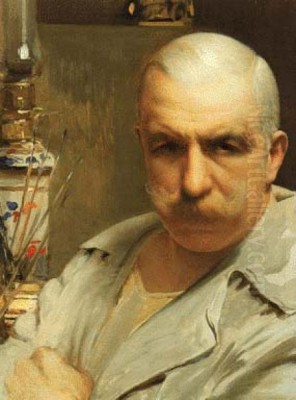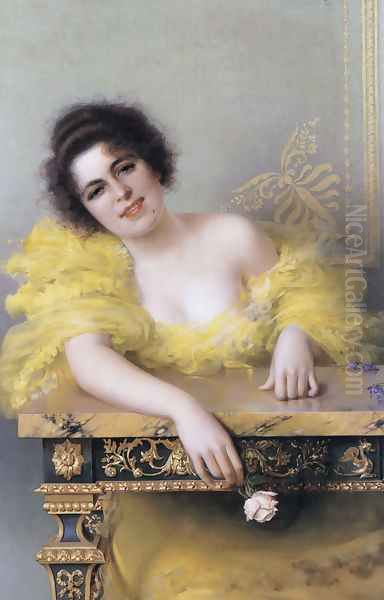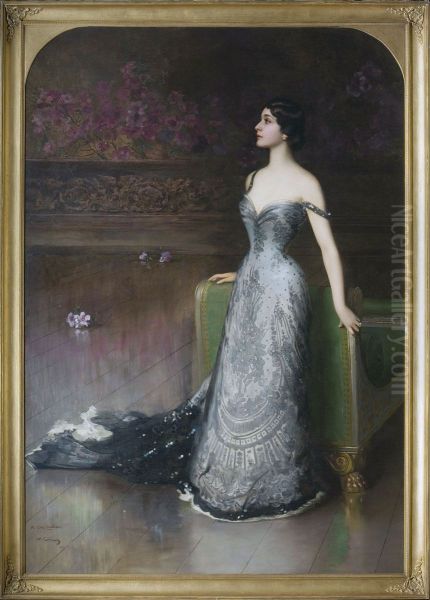
Vittorio Matteo Corcos stands as a significant figure in late 19th and early 20th-century Italian art. Renowned primarily for his captivating portraits, especially of elegant women, and his refined genre scenes, Corcos navigated the vibrant art worlds of Florence, Naples, and Paris, leaving behind a legacy of technically brilliant and aesthetically pleasing works that capture the spirit of the Belle Époque. His paintings are celebrated for their meticulous detail, masterful handling of light, and insightful portrayal of his subjects.
Early Life and Artistic Formation
Vittorio Matteo Corcos was born in Livorno, Italy, on October 4, 1859, into a Jewish family. His parents were Isacco Corcos and Giuditta Corcos. Showing artistic promise early on, he embarked on his formal training in 1870 at the Accademia di Belle Arti di Firenze (Florence Academy of Fine Arts). There, he studied under the tutelage of Enrico Pollastrini, absorbing the academic traditions prevalent at the time.
Seeking further development, Corcos moved to Naples to study with Domenico Morelli between 1878 and 1879. Morelli was a towering figure in Italian art, known for his dramatic historical and religious paintings, often infused with literary references, particularly from the works of Lord Byron. Morelli's emphasis on formal study, combined with his romantic sensibilities and narrative depth, undoubtedly exerted a considerable influence on the young Corcos, shaping his technical skills and perhaps his approach to capturing mood and character.
The Parisian Years: Recognition and Influence
The year 1880 marked a pivotal moment in Corcos's career as he relocated to Paris, the undisputed center of the art world at the time. This move proved highly fruitful. He quickly integrated into the city's artistic circles, partly through his friendship with fellow Italian painter Giuseppe De Nittis. De Nittis, already established in Paris, introduced Corcos to an influential group of artists and writers, including Impressionist masters like Edgar Degas and Édouard Manet, as well as Gustave Caillebotte, and literary figures such as Alphonse Daudet and Edmond de Goncourt. Exposure to these avant-garde figures and the vibrant Parisian art scene broadened Corcos's horizons.

In Paris, Corcos also connected with the prominent portraitist Léon Bonnat. Perhaps most significantly for his commercial success, Corcos signed a lucrative 15-year contract with the renowned art dealership Goupil & Cie. This gallery specialized in marketable contemporary art and played a crucial role in promoting artists internationally. Under this contract, Corcos focused primarily on producing portraits, particularly of aristocratic women, and charming genre scenes depicting moments of everyday life among the fashionable elite.
His works from this period gained considerable acclaim. Critics and collectors praised his exquisite attention to detail, the delicate rendering of fabrics and textures, and his sophisticated manipulation of light and shadow. He exhibited regularly at the prestigious Paris Salon, further enhancing his reputation. Beyond easel painting, Corcos also engaged in illustration work, creating images for magazines, posters, and book covers, which helped disseminate his style and name to a wider public. His Parisian output reflects the elegance and modernity of the city, often compared stylistically to the work of contemporaries like his friend Giovanni Boldini and Giuseppe De Nittis himself, both masters of capturing the fashionable Parisian life.
Return to Florence: Maturity and Notable Portraits
Despite his success in France, Corcos decided to return to Italy in 1886. He chose Florence as his permanent residence, reconnecting with his Italian roots while bringing back the sophistication and technical polish honed during his Parisian years. That same year, he married Emma Ciabatti (sometimes cited as Cibattari), a widow, establishing a family life in the Tuscan capital.
Back in Florence, Corcos continued to be a sought-after portraitist. He painted numerous prominent figures from Italian cultural and social life. His sitters included fellow artists like the Macchiaioli painter Silvestro Lega, the celebrated poet and Nobel laureate Giosue Carducci, the renowned composer Pietro Mascagni, and figures like Pietro Menghi. His reputation extended even into the political sphere, as evidenced by later portraits, including one of Benito Mussolini, and society figures like Countess Annina Morini.
These portraits cemented his status as a leading painter in Italy. He skillfully balanced likeness with an idealized elegance, capturing not just the physical features but also the perceived social standing and personality of his sitters. His Florentine studio became a hub where art and society intersected, reflecting his established position within the cultural landscape of the time. He also maintained connections with the artistic community, later joining the Gruppo Labronico, an association of artists from his native Livorno.
Artistic Style and Themes

Vittorio Corcos developed a distinctive artistic style characterized by a blend of academic precision, Realism, and a certain Romantic sensibility, perfectly suited to the tastes of the Belle Époque. His technical mastery is evident in the smooth finish of his canvases, the meticulous rendering of details – from the textures of silk and velvet to the glint of jewelry – and his subtle use of color and light to create mood and volume.
His primary subjects were often elegant, fashionable women, depicted in moments of quiet contemplation, leisure, or social interaction. He excelled at capturing the nuances of expression and posture, suggesting an inner life beneath the polished exterior. Works like Sogni (Dreams) exemplify this, presenting a young woman lost in thought, her gaze inviting speculation. He often depicted his subjects in refined interiors or idyllic outdoor settings, enhancing the sense of grace and tranquility.
While portraiture was his mainstay, Corcos also painted genre scenes that offered glimpses into the lives of the bourgeoisie. Paintings like Stella and Piero (1889) show young people relaxing, capturing a moment of youthful ease and connection. His compositions are typically well-balanced, and his figures possess a tangible presence, often approaching life-size, which enhances their immediacy. The influence of photography, with its potential for capturing fleeting moments and precise detail, can perhaps be discerned in his work, though filtered through his own artistic vision. The overall atmosphere in his paintings is one of sophisticated charm, intimacy, and sometimes a gentle melancholy.
Key Works and Signature Pieces
Several paintings stand out as representative of Corcos's oeuvre and enduring appeal:
_Sogni (Dreams)_ (1896): Perhaps his most famous work, this painting depicts a young woman, identified as Elena Vecchi, seated on a public bench, seemingly lost in reverie. Her direct yet enigmatic gaze, combined with the title, invites viewers to ponder her thoughts. The painting is celebrated for its psychological depth and technical brilliance, capturing the textures of her dress and the ambient light with remarkable skill. The near life-size scale enhances its impact.
_Alla fontana (Le Due Colombe)_ (At the Fountain / The Two Doves) (1896): Also featuring Elena Vecchi, this work shows her seated confidently by a fountain (identified as the lion fountain outside the Pitti Palace in Florence). The presence of pigeons, traditional symbols of purity, might carry an ironic undertone given the modern assertiveness of the subject. It showcases Corcos's ability to blend portraiture with narrative elements and symbolic details within a specific, recognizable setting.
_Il Gatto Bianco (The White Cat)_ (circa 1890s): This charming portrait features a young woman dressed elegantly in a white velvet jacket and a striking green-blue cape, holding a white cat. The interplay of textures and the soft, dreamlike quality of the light create an atmosphere of intimate luxury and gentle mystery. It highlights Corcos's skill in rendering fabrics and capturing a tender moment.
_Stella and Piero_ (1889): This painting depicts a young man and woman in a relaxed outdoor setting, possibly engaged in conversation or shared contemplation. It captures a sense of youthful companionship and the leisurely pursuits of the upper class during that era, showcasing Corcos's ability to handle multi-figure compositions and naturalistic settings.
_Young Woman with a Dog_ (1891) and _Portrait of a Young Woman_ (1891): These titles likely refer to typical examples of his portraiture from the early 1890s, demonstrating his consistent focus on elegant female subjects and his refined technique during his Florentine period.
_La Zingara (Gypsy Girl)_: While less typical than his society portraits, this work is noted for demonstrating Corcos's versatility and his capacity for capturing strong character, utilizing vibrant color and expressive brushwork appropriate to the subject.
These works, among others, illustrate Corcos's consistent themes: the elegance of modern life, the inner world of his subjects (particularly women), and the beauty found in moments of quietude and leisure.
Personal Life and Anecdotes
Corcos's life, while centered around his art, included personal dimensions that shaped his experience. His relationship with the model Elena Vecchi was reportedly more than professional; she is believed to have been his lover for a time and features prominently in some of his most compelling works from the 1890s, such as Sogni and Alla fontana. This personal connection may have contributed to the psychological intensity of these paintings.
The First World War brought personal tragedy to Corcos's life. His son was killed in combat, a devastating loss that undoubtedly cast a shadow over his later years. Despite this profound grief, he continued to work and remained engaged with the art community, joining the Gruppo Labronico after the war.
Beyond his painting, Corcos possessed literary interests. He contributed articles to the Florentine cultural journal Il Marzocco and even published a short story titled "Mademoiselle Leprince" in the magazine Fanfulla della Domenica in 1886. This suggests a broader intellectual engagement with the cultural currents of his time.
Teacher and Student
Corcos's own artistic development was significantly shaped by his teachers, Enrico Pollastrini and, more importantly, Domenico Morelli. Morelli's influence, with his emphasis on historical context, literary depth, and strong technique, provided a solid foundation for Corcos. While specific details of their personal interactions are scarce, the master-student relationship in this era was typically one of guidance and inspiration, and Morelli's stature suggests he would have been a demanding yet formative mentor.
Corcos himself took on the role of teacher, although he is not primarily known for his pedagogical activities. One documented student is the Italian painter Cesare Maggi (1881-1961), who studied with Corcos in Florence around 1897. This indicates that Corcos did share his knowledge and skills with the next generation, passing on the traditions and techniques he had mastered.
Legacy and Evaluation
Vittorio Matteo Corcos enjoyed considerable success during his lifetime, particularly as a portraitist favored by the Italian and European elite. His work was appreciated for its technical perfection, elegance, and ability to capture the fashionable spirit of the age. However, his contemporary fame perhaps did not reach the heights of some of the more avant-garde artists who became icons of Modernism, such as his fellow Livorno-born painter Amedeo Modigliani.
In the decades following his death in Florence on November 8, 1933, Corcos's reputation experienced a period of relative obscurity, overshadowed by the dramatic shifts in artistic taste during the mid-20th century. However, recent decades have witnessed a resurgence of interest in his work. Art historians and collectors increasingly recognize his significant contribution to Italian art between the late 19th century and the early 20th century.
His paintings are valued not only for their aesthetic qualities – the beautiful rendering of surfaces, the graceful compositions, the sensitive portrayal of individuals – but also as historical documents. They offer a window into the world of the Belle Époque, reflecting its fashions, social customs, and psychological nuances. His depictions of women, in particular, are noted for capturing a blend of traditional elegance and emerging modernity.
Today, Vittorio Matteo Corcos's works are held in prestigious public collections, including the Uffizi Gallery (specifically the Gallery of Modern Art at Palazzo Pitti) in Florence and the Galleria Nazionale d'Arte Moderna e Contemporanea in Rome, as well as numerous private collections worldwide. His paintings continue to fetch significant prices at auction, indicating sustained market appreciation. He is remembered as a master technician, a sensitive portraitist, and a quintessential painter of Belle Époque elegance, whose art continues to charm and engage viewers.
Conclusion
Vittorio Matteo Corcos carved a distinct niche for himself within the rich tapestry of Italian art. From his formative years under influential masters like Domenico Morelli to his successful career spanning Florence, Paris, and back to Florence, he consistently produced works of high technical quality and refined aesthetic sensibility. His portraits, especially of women, remain his most celebrated achievement, capturing the elegance, poise, and subtle psychology of his subjects with remarkable skill. While navigating the currents of Realism, Impressionism, and Symbolism, he maintained a signature style that resonated with the tastes of his time and continues to find appreciation today. As a chronicler of the Belle Époque and a master of elegant representation, Corcos holds a secure place in the history of European art.